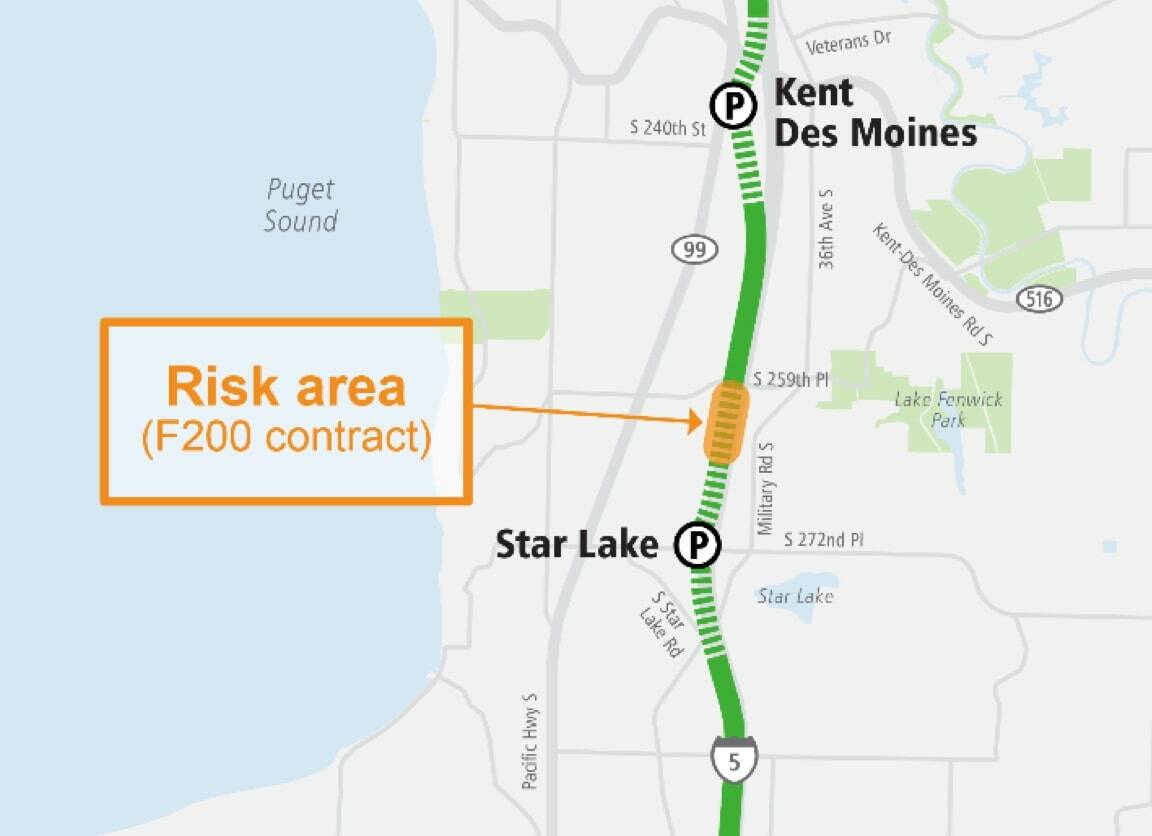The Federal Way Link Extension is one of four Sound Transit projects facing delays due to construction challenges, according to a new report provided to the Sound Transit Board System Expansion Committee on Thursday.
These delays push back the projected opening dates for the East Link, Lynnwood, Federal Way and Downtown Redmond Link Extension routes. Signs of possible delays were tracked since April both due to nationwide issues, but also particular challenges at individual sites, according to Sound Transit.
In Federal Way, an “unexpected” ground instability issue for the project may result in a redesigning of the route section in Kent, adjacent to I-5 and South 259th Place. Sound Transit said it is too early to tell the length of the construction delay, but expects the Federal Way Link Extension to open in 2025 instead of the projected opening of late 2024.
Last month, approximately 200 linear feet of embankment slid downslope by approximately nine feet, requiring a roughly three-day precautionary lane closure on southbound I-5. While the slope is temporarily stabilized, Sound Transit and the design-build contractor, Kiewit, are working with the Washington State Department of Transportation to develop permanent design solutions. This involves addressing a liquefiable layer of soil that has been identified fairly deep below the light rail alignment.
Another aspect impacting the delay of the Federal Way Link opening timeline is the traffic mitigation commitments.
Traffic mitigation is an environmental requirement to lessen impacts related to the operation of the extension and includes 10 separate sites for improvements to intersections, according to a Sound Transit memo.
Improvements are expected to be finished before the Federal Way Link route opens. Risks include delays or legal challenges to right-of-way possession, and use and acquisition preventing the right-of-way from being acquired in a timely manner. Local jurisdictions requiring additional design modifications and delays in necessary utility relocations are also threatening the scheduled opening timeline.
Eastside projects
Both the east and west sides of the I-90 floating bridge are also facing delays due to issues with cast-in-place concrete plinths supporting the tracks. Problems have been identified with mortar pads, rebar placements and track fasteners, which the project contractor has agreed to fix by re-casting the plinths to ensure the long-term reliability and safety of the extension, according to Sound Transit. A forensic engineering firm determined the pre-cast concrete blocks supporting tracks on the bridge do not need to be replaced, according to a preliminary investigation done in July and August.
For the East Link route, Sound Transit’s original plan was to open in mid-2023. Now, the agency estimates the project will be delayed by at least a year due to construction challenges.
As new project timelines are still being assessed, the agency expects completion of construction for the Lynnwood and Redmond projects to be delayed four to six months beyond the planned mid-2024 opening. This is “slightly exceeding” the more than four-month delay caused by the concrete delivery strike that ended in April, according to Sound Transit.
The Downtown Redmond Link Extension delay is also related to challenges that arise from staffing and supply chain issues, managing potential changes in design as lessons are learned on other projects, and power connection issues.
Next steps
Sound Transit is focusing on solving the delay risks and opening the projects without changing the order in which they enter operations — East Link followed by Lynnwood, Federal Way and then Redmond, according to the memo.
The agency has action plans in place to address and solve the projects’ delay risks.
“Additionally, staff have implemented changes supporting intensified inspections and monitoring of contractors’ work,” according to a news release from the agency.
This includes conducting a programmatic risk assessment to analyze the implications of the projects.
“Since each project is part of a system, we need to look at the projects’ current status at a programmatic level, with focus on details of project sequencing,” the agency stated.
The programmatic analysis is “critical” because after construction, light rail segments must be activated sequentially within appropriate safety and staffing parameters with up to six months of testing prior to activating each segment.
Talk to us
Please share your story tips by emailing editor@kentreporter.com.
To share your opinion for publication, submit a letter through our website https://www.kentreporter.com/submit-letter/. Include your name, address and daytime phone number. (We’ll only publish your name and hometown.) Please keep letters to 300 words or less.

